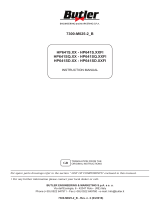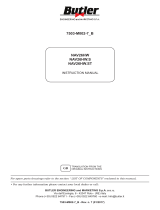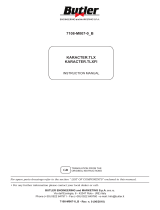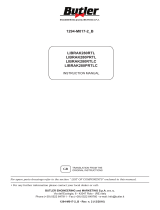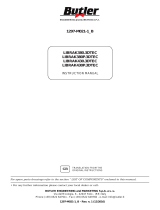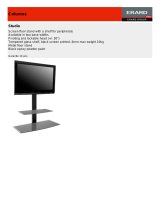
GB
TRANSLATION FROM THE
ORIGINAL INSTRUCTIONS
INSTRUCTION MANUAL
• For any further information please contact your local dealer or call:
For spare parts drawings refer to the section “ LIST OF COMPONENTS” enclosed to this manual.
- Rev. n. 8 (03/2018)
SEIDO.30
SEIDO.30FI
7105-M005-8_B
BUTLER ENGINEERING and MARKETING S.p.A. a s. u.
Via dell’Ecologia, 6 - 42047 Rolo - (RE) Italy
Phone (+39) 0522 647911 - Fax (+39) 0522 649760 - e-mail: Info@butler.it
7105-M005-8_B

Page 2 of 38
GB
INSTRUCTION, USE AND
MAINTENANCE MANUAL
SEIDO.30 - SEIDO.30FI
7105-M005-10_B
SUMMARY
SYMBOLS USED IN THE MANUAL ________ 4
1.0 GENERAL INTRODUCTION __________ 6
1.1 Introduction ____________________________ 6
2.0 INTENDED USE _____________________ 6
2.1 Staff training __________________________ 6
3.0 SAFETY DEVICES ___________________ 7
3.1 Residual risks __________________________ 7
4.0 GENERAL SAFETY RULES __________ 7
5.0 PACKING AND MOBILIZATION FOR
TRANSPORT ________________________ 8
6.0 UNPACKING _________________________ 9
7.0 MOBILIZATION ______________________ 9
8.0 WORKING ENVIRONMENT CONDI-
TIONS ______________________________ 10
8.1 Installation space _____________________10
9.0 ANCHORING SYSTEM ______________ 10
10.0 ASSEMBLY AND PREPARATION FOR
USE ________________________________ 11
10.1 Fixtures contained in the packing _____11
10.2 Assembly procedures _________________11
10.3 Electrical connection __________________12
10.4 Working area modification ____________12
10.5 Controls _______________________________13
11.0 CONTROLS _________________________ 14
11.1 Control device (see Fig. 14) ___________14
11.2 Pedalboard (see Fig. 15) ______________14
12.0 USING THE MACHINE ______________ 15
12.1 Precaution measures during tyre re-
moval and fitting ______________________15
12.2 Preliminary operations - Preparing
the wheel ______________________________15
12.3 Wheel clamping _______________________15
12.3.1 Reverse wheel pan protection ______17
12.4 Bead breaking through vertical rollers 18
12.5 Demounting the tyre __________________19
12.6 Mounting the tyre _____________________22
12.7 Special use of the bead-breaker _______23
12.8 Tyre inflation with machine without
tubeless inflation ______________________24
12.9 Tyre inflation with machine with tube-
less inflation
__________________________24
13.0 ROUTINE MAINTENANCE __________ 25
13.1 Lubricants ____________________________26
14.0 TROUBLESHOOTING TABLE _______ 27
15.0 TECHNICAL DATA __________________ 28
15.1 Weight _________________________________28
15.2 Dimensions ____________________________29
16.0 STORING ___________________________ 30
17.0 SCRAPPING ________________________ 30
18.0 REGISTRATION PLATE DATA ______ 30
19.0 FUNCTIONAL DIAGRAMS __________ 30
Table A - Electric diagram __________________31
Table B - Pneumatic diagram
_______________33
Table C - Pneumatic diagram FI
____________36
20.0 LIST OF COMPONENTS

Page 3 of 38
INSTRUCTION, USE AND
MAINTENANCE MANUAL
GB
1
2
3
4
5
6
7
8
9
11
12
10
1
2
3
4
5
6
7
8
9
10
11
KEY
1 – Mandrel
2 – Tool
3 – Upper bead breaker
4 – Lower bead breaker
5 – Control panel
6 – Lateral pedalboard
7 – Frontal pedalboard
8 – Complete column
9 – Filter unit - pressure reducer
10 – Locking device
11 – Lifting device (on demand)
KEY
1 – Mandrel
2 – Tool
3 – Upper bead breaker
4 – Lower bead breaker
5 – Control panel
6 – Lateral pedalboard
7 – Frontal pedalboard
8 – Complete column
9 – Filter unit - pressure reducer
10 – Tubeless inflation unit
11 – Locking device
12 – Lifting device (on demand)
SEIDO.30 - SEIDO.30FI
7105-M005-10_B
FIG. 1 - SEIDO.30
FIG. 2 - SEIDO.30FI

Page 4 of 38
GB
INSTRUCTION, USE AND
MAINTENANCE MANUAL
SYMBOLS USED IN THE MANUAL
Symbols Description
Read instruction manual.
Wear work gloves.
Wear work shoes.
Mandatory. Operations or jobs to
be performed compulsorily.
Danger! Be particularly careful.
Symbols Description
Move with fork lift truck or pallet
truck.
Lift from above.
Wear safety goggles.
Technical assistance necessary.
Do not perform any intervention.
Warning. Be particularly careful
(possible material damages).
Note. Indication and/or useful
information.
SEIDO.30 - SEIDO.30FI
7105-M005-10_B

Page 5 of 38
INSTRUCTION, USE AND
MAINTENANCE MANUAL
GB
B1594000
B2170000
B4182000
B1541000
B2166000
B2167000
B2168000
B3691000
B4244000
B6419000
710211210
99990758
*
•
999916311
■
999919680
Date indicating plate
Max inflation pressure rating plate
Electric motor specifications plate
Danger plate
Hand crushing danger plate
Obligation to wear protective clothing plate
Tyre burst plate
Inflation pedal plate
Rotating parts danger plate
Rotation plate
Rotation direction plate
Electricity danger plate
Manufacturer label
Serial number plate
Rubbish skip label
Manufacturer nameplate
Controls label
PLATE LOCATION ON MACHINE INFORMATION TABLE
Code numbers of plates
IF ONE OR MORE PLATES DISAPPEARS FROM THE MACHINE OR BECOMES DIFFICULT
TO READ. REPLACE IT AND QUOTE ITS/THEIR CODE NUMBER/S WHEN REORDERING.
SEIDO.30 - SEIDO.30FI
7105-M005-10_B

Page 6 of 38
GB
INSTRUCTION, USE AND
MAINTENANCE MANUAL
SOME OF THE PICTURES PRE-
SENT IN THIS MANUAL HAVE
BEEN OBTAINED FROM PICTURES
OF PROTOTYPES, THEREFORE
THE STANDARD PRODUCTION
MACHINES AND ACCESSORIES
CAN BE DIFFERENT IN SOME
COMPONENTS.
1.0 GENERAL INTRODUCTION
This manual is an integral part of the product and
must be retained for the whole operating life of the
machine.
Carefully study the warnings and instructions contai-
ned in this manual. It contains important instructions
regarding FUNCTIONING, SAFE USE and MAINTE-
NANCE.
KEEP THE MANUAL IN A KNOWN,
EASILY ACCESSIBLE PLACE FOR
ALL ACCESSORY OPERATORS
TO CONSULT IT WHENEVER IN
DOUBT.
THE MANUFACTURER DISCLAIMS
ALL RESPONSIBILITY FOR ANY
DAMAGE OCCURRED WHEN THE
INDICATIONS GIVEN IN THIS MA-
NUAL ARE NOT RESPECTED: AS
A MATTER OF FACT, THE NON-
COMPLIANCE WITH SUCH INDI-
CATIONS MIGHT LEAD TO EVEN
SERIOUS DANGERS.
1.1 Introduction
Thank you for preferring this tyre-changer. We feel sure
you will not regret your decision.
This machine has been designed for use in professional
workshops and stands out for its reliability and easy,
safe and rapid operation: with a minimum mainte-
nance and care this tyre changer will operate for many
years without problems, thus satisfying Your needs.
2.0 INTENDED USE
The machines described in this manual and their
different versions, is a tyre-changer for car tires
projected to be used exclusively for the mounting,
demounting, and inflation of wheels with dimensions
of max. diameter of 45" and max. width of 15".
THIS ACCESSORY MUST ONLY BE
USED FOR THE PURPOSE FOR
WHICH IT IS SPECIFICALLY DE-
SIGNED.
ANY OTHER USE IS CONSIDERED
IMPROPER AND THEREFORE
UNACCEPTABLE.
THE MANUFACTURER CANNOT
BE HELD RESPONSIBLE FOR ANY
DAMAGE CAUSED BY IMPROPER,
ERRONEOUS, OR UNACCEPTABLE
USE.
AN INTENSIVE USE OF THE
EQUIPMENT IN INDUSTRIAL EN-
VIRONMENT IS NOT RECOMMEN-
DED.
2.1 Staff training
The machine may be operated only by suitably
trained and authorized personnel.
Given the complexity of the operations necessary to
manage the machine and to carry out the operations
safely and efficiently, the personnel must be trained
in such a way that they learn all the information
necessary to operate the machine as intended by the
manufacturer.
A CAREFUL READING OF THIS
INSTRUCTION MANUAL FOR USE
AND MAINTENANCE AND A SHORT
PERIOD OF TRAINING WITH SKIL-
LED PERSONNEL CAN BE AN
ENOUGH PREVENTIVE PREPARA-
TION.
SEIDO.30 - SEIDO.30FI
7105-M005-10_B

Page 7 of 38
INSTRUCTION, USE AND
MAINTENANCE MANUAL
GB
3.0 SAFETY DEVICES
PERIODICALLY, AT LEAST
MONTHLY, CHECK THE INTEGRI-
TY AND THE FUNCTIONALITY OF
THE SAFETY AND PROTECTION
DEVICES ON THE MACHINE.
All the machines are equipped with:
• man-operated controls (immediate stop of operation
when the control is released) for all operating devices;
• mandrel rotation;
• tool translation;
• bead breaking roller translation.
• Non-adjustable pressure limiter.
This allows inflation of tyres in reasonable safety.
Inflation of tyres to over 4,2 ± 0,2 bar (60 PSI) is
not allowed.
• Controls logic disposition
Its function is to prevent the operator from dange-
rous mistakes.
• Motor protection devices
The new “Invemotor” motor is equipped with elec-
tronic protection devices. They stop the motor if
working defected conditions appear to avoid that the
motor itself can be damaged and that the operator
safety can be compromised (overvoltage, overload,
overtemperature). For other details, see the chapt.
14 “Fault-Finding”.
3.1 Residual risks
The machine was subjected to a complete analysis of
risks according to reference standard EN ISO 12100.
Risks are as reduced as possible in relation with
technology and product functionality.
This manual stresses possible residual risks, also hi-
ghlighted in pictograms and adhesive warning signals
placed on the machine: their location is represented
in “PLATE LOCATION ON MACHINE INFORMATION
TABLE” on page 5.
4.0 GENERAL SAFETY RULES
• Any tampering with or modification to the machi-
ne not previously authorized by the manufacturer
exempts the latter from all responsibility for damage
caused by or derived from said actions.
• Removing of or tampering with the safety devices or
with the warning signals placed on the machine leads
to serious dangers and represents a transgression of
European safety rules.
• The machine may be used only in areas free from
the danger of explosion or fire.
• The use of only original accessories and spare parts
is advised. Our machine is designed to function only
with original accessories.
• Installation must be conducted only by qualified
personnel exactly according to the instructions that
are given below.
• Ensure that there are no dangerous situations during
the machine operating manoeuvres. Immediately
stop the machine if it malfunctions and contact the
assistance service of an authorized dealer.
• In emergency situations and before carrying out any
maintenance or repairs, disconnect all supplies to
the machine by using the main switch.
• Ensure that the work area around the machine is free
of potentially dangerous objects and that there is no
oil since this could damage the tyre. Oil on the floor
is also a potential danger for the operator.
OPERATORS MUST WEAR SUITA-
BLE WORK CLOTHES, PROTEC-
TIVE GLASSES AND GLOVES,
AGAINST THE DANGER FROM THE
SPRAYING OF DANGEROUS DUST,
AND POSSIBLY LOWER BACK SUP-
PORTS FOR THE LIFTING OF HE-
AVY PARTS. DANGLING OBJECTS
LIKE BRACELETS MUST NOT BE
WORN, AND LONG HAIR MUST
BE TIED UP. FOOTWEAR SHOULD
BE ADEQUATE FOR THE TYPE
OF OPERATIONS TO BE CARRIED
OUT.
SEIDO.30 - SEIDO.30FI
7105-M005-10_B

Page 8 of 38
GB
INSTRUCTION, USE AND
MAINTENANCE MANUAL
Fig. 3
• The machine handles and operating grips must be
kept clean and free from oil.
• The workshop must be kept clean, dry and not
exposed to atmospheric agents. Make sure that the
working premises are properly lit.
The machine can be operated by a single operator.
Unauthorised personnel must remain outside the
working area, as shown in Figure 5.
Avoid any hazardous situations. Do not use air-
operated or electrical equipment when the shop is
damp or the floor slippery and do not expose such
tools to atmospheric agents.
• During inflation do not lean on the tyre or remain
above it. When beading in the tyre, keep hands away
from tyre and the rim edge.
• During inflation always stay to the side of the machine
and never in front of it.
• When operating and servicing this machine, carefully
follow all applicable safety and accident-prevention
precautions.
The machine must not be operated by professionally
unskilled persons.
IN CASE OF A CHANCE SUPPLY
FAILURE MOVE THE CONTROLS
TO THE NEUTRAL POSITION.
5.0 PACKING AND MOBILIZATION FOR
TRANSPORT
HAVE THE MACHINE HANDLED BY SKILLED
PERSONNEL ONLY.
THE LIFTING EQUIPMENT MUST WITHSTAND
A MINIMUM RATED LOAD EQUAL TO THE
WEIGHT OF THE PACKED MACHINE.
The machine is packed completely assembled. The
machine is inside a carton box which size is mm
1460x1160x2000.
Movement must be by pallet-lift or fork-lift trolley.
The fork lifting points are indicated on the packing.
SEIDO.30 - SEIDO.30FI
7105-M005-10_B

Page 9 of 38
INSTRUCTION, USE AND
MAINTENANCE MANUAL
GB
1
6.0 UNPACKING
WHEN UNPACKING THE MACHI-
NE, ALWAYS WEAR GLOVES TO
PREVENT SCRATCHES AND CUTS
CAUSED BY CONTACT WITH PA-
CKING MATERIAL (NAILS, ETC...).
The cardboard box is supported with plastic strapping.
Cut the strapping with suitable scissors. Use a small
knife to cut along the lateral axis of the box and open
it like a fan.
It is also possible to unnail the cardboard box from
the pallet it is fixed to. After removing the packing,
and in the case of the machine packed fully assembled,
check that the machine is complete and that there is
no visible damage.
If in doubt do not use the machine and refer to pro-
fessionally qualified personnel (to the seller).
The packing (plastic bags, expanded polystyrene, nails,
screws, timber, etc.) should not be left within reach of
children since it is potentially dangerous. These ma-
terials should be deposited in the relevant collection
points if they are pollutants or non biodegradable.
THE BOX CONTAINING THE FIXTU-
RES IS CONTAINED IN THE WRAP-
PING. DO NOT THROW IT AWAY
WITH THE PACKING.
Fig. 4
7.0 MOBILIZATION
THE LIFTING EQUIPMENT MUST WITHSTAND
A MINIMUM RATED LOAD EQUAL TO THE
WEIGHT OF THE MACHINE (SEE PARAGRAPH
TECHNICAL SPECIFICATIONS). DO NOT AL-
LOW THE LIFTED MACHINE TO SWING.
If the machine has to be moved from its normal work
post, the movement must be conducted following the
instructions listed below.
• Protect the exposed corners with suitable material
(Pluribol/cardboard).
• Do not use metallic cables for lifting.
• Make sure the electrical and pneumatic supply of the
machine is not connected.
• Sling with belts long at least 450 cm and with a ca-
pacity load greater than 2500 kg.
Then carry out the lifting using the bracket (Fig. 4
ref. 1).
SEIDO.30 - SEIDO.30FI
7105-M005-10_B

Page 10 of 38
GB
INSTRUCTION, USE AND
MAINTENANCE MANUAL
~ 1000
~ 1000
3250
2750
~ 1000
b
a
X
X
X
X
X
1
1
Fig. 5
8.0 WORKING ENVIRONMENT CONDI-
TIONS
The machine must be operated under proper condi-
tions as follows:
• temperature: 0° + 55° C
• relative humidity: 30 - 95% (dew-free)
• atmospheric pressure: 860 - 1060 hPa (mbar).
The use of the machine in ambient conditions other
than those specified above is only allowed after prior
agreement with and approval of the manufacturer.
8.1 Installation space
The holes in the solid floor must be about 10 cm deep
with a diameter of 8 MA.
The small blocks (Fig. 6 ref. 1) must be inserted in the
holes pre-arranged and fully tightened until reaching
the system full seal.
Before fixing completely the machine to the ground,
flush its rear part rotating its feet (Fig. 7 Ref. 1).
9.0 ANCHORING SYSTEM
The packed machine is fixed to a pallet by support feet.
Such feet also fix the machine to the ground through
anchor small blocks as shown in Fig. 6.
Fig. 6
a=621 mm
b=440 mm
Fig. 7
INSTALL THE MACHINE INDOORS OR IN A RO-
OFED AREA. PLACE OF INSTALLATION MUST
BE DRY, ADEQUATELY LIT AND IN COMPLIAN-
CE WITH APPLICABLE SAFETY REGULATIONS.
The location of the machine requires a usable space of
3250x2750, mm (as indicated in Fig. 5). The positio-
ning of the machine must be according to the distances
shown. From the control position the operator is able
to observe all the machine and surrounding area. He
must prevent unauthorized personnel or objects that
could be dangerous from entering the area.
The machine must be fixed on a flat floor surface, pre-
ferably of cement or tiled. Avoid yielding or irregular
surfaces.
The base floor must be able to support the loads
transmitted during operation. This surface must have
a strength of at least 500 kg/m².
The depth of the solid floor must be sufficient to gua-
rantee that the anchoring bolts hold.
SEIDO.30 - SEIDO.30FI
7105-M005-10_B

Page 11 of 38
INSTRUCTION, USE AND
MAINTENANCE MANUAL
GB
1
3
1
2
4
4
5
5
6
1
2
10.0 ASSEMBLY AND PREPARATION FOR
USE
After having freed the various components from the
packing check that they are complete, and that there
are no anomalies, then comply with the following in-
structions for the assembly of the components making
use of the attached series of illustrations.
10.1 Fixtures contained in the packing
The packing case contains also the fixtures box.
Check that all the parts listed are there.
Code Description N.
710090223
Quick coupling 1
B1157000
Two-faced cone 1
710013421
Reverse wheels protection 1
710090730
Traction tool 1
790011620
Bead sliding foil 1
790011640
Instructions for bead sliding
foil
1
10.2 Assembly procedures
1. Assemble “Tubeless inflation” unit to the machine
keeping to the following instructions:
- fix the tank (Fig. 8 ref. 6) to the support flange
(Fig. 8 ref. 2) using the screws (Fig. 8 ref. 4) and
nuts (Fig. 8 ref. 5) equipped on issue;
- fix the flange (Fig. 8 ref. 2) to the machine (Fig. 8
ref. 3) using the screws (Fig. 8 ref. 1);
Fig. 8
2. Connect the black pipe (Fig. 9 ref. 1) and the blue
pipe (Fig. 9 ref. 2) on the provided quick couplings
as shown in figure 9.
3. Mount the grease bucket holder ring (# 0223000)
(Fig. 10 ref. 1), in the accessory box, using the 2
provided screws already present on machine body
(Fig. 10 ref. 2).
4 - Connect the mains pneumatic power supply by
using the union placed on filter unit of the machine.
The pressurized pipe coming from the mains must
have a section of 10x19 (see Fig. 11).
Fig. 10
Fig. 9
Fig. 10
SEIDO.30 - SEIDO.30FI
7105-M005-10_B

Page 12 of 38
GB
INSTRUCTION, USE AND
MAINTENANCE MANUAL
A
B
The machine is supplied with 3 m of free cable. A plug
corresponding to the following requirements must be
connected to the cable:
• Conformity to Norm IEC 309
• 230 Volt – 16A
• 2P + Ground
• IP 44
Fig. 12
10.3 Electrical connection
EVEN THE TINIEST PROCEDURE
OF AN ELECTRICAL NATURE MUST
BE CARRIED OUT BY PROFESSIO-
NALLY QUALIFIED STAFF.
BEFORE CONNECTING THE MA-
CHINE MAKE SURE THAT:
• THE MAIN POWER RATING COR-
RESPONDS TO THE MACHINE
RATING AS SHOWN ON THE
MACHINE PLATE;
• ALL MAIN POWER COMPO-
NENTS ARE IN GOOD CONDI-
TION;
• THE ELECTRICAL SYSTEM
IS PROPERLY GROUNDED
(GROUND WIRE MUST BE THE
SAME CROSS-SECTION AREA
AS THE LARGEST POWER SUP-
PLY CABLES OR GREATER);
• MAKE SURE THAT THE ELEC-
TRICAL SYSTEM FEATURES A
CUTOUT WITH DIFFERENTIAL
PROTECTION SET AT 30 MA.
As envisaged by the regulations in force, the machine is
not equipped with a master circuit breaker, but simply
has a plug-socket connection to the electrical mains.
FIT A TYPE-APPROVED PLUG
TO THE MACHINE CABLE (THE
GROUND WIRE IS YELLOW/GRE-
EN AND MUST NEVER BE CON-
NECTED TO ONE OF THE PHASE
LEADS).
MAKE SURE THAT THE ELEC-
TRICAL SYSTEM IS COMPATIBLE
WITH THE RATED POWER AB-
SORPTION SPECIFIED IN THIS
MANUAL AND APT TO ENSURE
THAT VOLTAGE DROP UNDER
FULL LOAD WILL NOT EXCEED
4% OF RATED VOLTAGE (10%
UPON START-UP).
VERSION WITH
SINGLE-PHASE MOTOR
On delivery, the machine is pre-set to operate at a
single-phase voltage of 200 ÷ 265 V - 50/60 Hz.
FAILURE TO OBSERVE THE ABO-
VE INSTRUCTIONS WILL IMME-
DIATELY INVALIDATE THE WAR-
RANTY.
10.4 Working area modification
After the delivery, the machine is prearranged to op-
erate on wheel of 41” maximum diameter and a rim
diameter (10” - 26”). It’s also possible to move the tools
column to enlarge the working area from 43” (with rim
diameter of 12” - 28”) up to 45” (with rim diameter of
14” - 30”) (see Figure 12).
SEIDO.30 - SEIDO.30FI
7105-M005-10_B

Page 13 of 38
INSTRUCTION, USE AND
MAINTENANCE MANUAL
GB
2
3
7
4
4
43" 41"
45"
5
1
3
5
3
5
6
The column is moved by unloosing the fixing screws of
the base (Fig. 12 ref. A) to the column (Fig. 12 ref. B)
and by sliding the base (Fig. 12 ref. A) itself into the
proper slots until the required measure.
MAKE SURE THAT THE TYRE-
CHANGER COLUMN IS STABLE:
USE A CABLE HELD BY A HOIST
AND HOOK THE CABLE TO THE
COLUMN ITSELF (FIG. 13 REF. 7).
1. Remove the lateral guard (Fig. 13 ref. 1-2) of the
machine.
2. Unscrew the screws (Fig. 13 ref. 3) and the nuts
near the central slots (Fig. 13 ref. 4) paying atten-
tion not to remove the nuts from the proper screws.
3. Remove the six remaining screws (Fig. 13 ref. 5).
4. Move the base (Fig. 13 ref. 6) into the required
position (to 43” or 45”) and if necessary, use a lifting
device (Fig. 13 ref. 7).
5. Lock the base three screws (Fig. 13 ref. 3) with a
couple of 80 Nm.
6. Place six screws (Fig. 13 ref. 5) previously remo-
ved and lock them on the bases side with a couple
of 80 Nm.
7. Assemble again the lateral guards (Fig. 13 ref. 1-2)
of the machine.
NOTE: after the assembly, check the correct position
of the tools. Lock the rim on the mandrel cen-
tre. With the bead breaker arm, check that the
distance between the roll and the rim edges
(upper and lower) is the same. Repeat all the
procedures starting from point 1 if the distance
is not the same.
Fig. 13
10.5 Controls
BEFORE STARTING UP THE TYRE-
CHANGER, BE SURE TO BECOME
FAMILIAR WITH THE LOCATION
AND OPERATION OF ALL CON-
TROLS AND CHECK THEIR PRO-
PER OPERATION (SEE PAR. “CON-
TROLS”).
CARRY OUT A DAILY CHECK OF
MAINTAINED-TYPE CONTROLS
CORRECT FUNCTIONING, BE-
FORE STARTING MACHINE OP-
ERATION.
SEIDO.30 - SEIDO.30FI
7105-M005-10_B

Page 14 of 38
GB
INSTRUCTION, USE AND
MAINTENANCE MANUAL
A
B
C
D
E
G2
G1
H
I
M
L
F1
F
F2
G
11.1 Control device (see Fig. 14)
The control device consists of a panel with integrated
keys and push buttons.
• • Handle “H” : through a thrust and return move-
ment and together with “I” unlocking push button it
enables the tool setting on the wheel diameter.
•
• Handle “L” : through a thrust and return move-
ment and together with “M” unlocking push button
it enables the bead breaker rolls setting on the wheel
diameter.
• Unlocking push button “I” pushed before handle “H”
for tool positioning. Releasing the push button, the
tool locks itself into the set position.
• Unlocking push button “M” pushed before handle “L”
for bead breakers positioning. Releasing the push
button, the rolls lock into the set position.
ATTENTION: “I” and “M” push buttons must be
pressed before operating the corresponding “H” and
“L” handles; otherwise, the levers do not allow any
movement.
Panel C consists of:
• Push button “A”, with a maintained action position.
When pressed, it controls the tool vertical downwards
translation.
• Push button “B”, with a maintained action position.
When pressed, it controls the tool vertical upwards
translation.
Fig. 14
11.0 CONTROLS
• Push button “D” has a maintained action position
and when it is pressed it controls the rotation, and,
at the same time, the introduction of the upper bead
breaker in the rim.
• Push button “E” has a maintained action position
and when it is pressed it controls the rotation, and,
at the same time, the introduction of the lower bead
breaker in the rim.
• Push buttons “F” have a maintained action posi-
tion and they control the vertical translation of the
upper bead breaker roll. When pressed in its lower
part (F2), it operates the downwards translation.
When pressed in its upper part (F1), it operates the
upwards translation. When the push button (F1) is
pressed, the release of the upper bead breaker roll
is also operated, if it has been previously introduced
with push button (D).
•
Push buttons “G” have a maintained action position
and they control the vertical translation of the lower
bead breaker roll. When pressed in its lower part (G2),
it operates the downwards translation. When the push
button (G2) is pressed, the release of the lower bead
breaker roll is also operated, if it has been previously
introduced with push button (E). When pressed in its
upper part (G1), it operates the upwards translation.
11.2 Pedalboard (see Fig. 15)
“Pedal A” has two maintained action operative posi-
tions. When it is pushed downwards it controls man-
drel motor clockwise rotary movement. When the pedal
is lifted upwards it operates the opposite movement.
NOTE: The mandrel unit speed can be continuously
adjusted up to the maximum speed through
a progressive pressure on the pedal, only in
clockwise direction.
“Pedal B” has a different function according to the the
version present on the machine.
Version with inflation with pressure gauge
The inflation pedal in this version has only one fun-
ction. A continuous pressure supplies air at a control-
led pressure (max 4 ± 0,2 bar 58 PSI).
DO NOT CHANGE THE SET OPE-
RATING PRESSURE VALUE BY ME-
ANS OF THE MAXIMUM PRESSURE
VALVES. THE MANUFACTURER
SHALL NOT BE RESPONSIBLE
FOR INJURY OR DAMAGE ARISING
FROM UNAUTHORISED CHANGES.
Version with tubeless inflation
The inflation pedal has two functions. The supply of
air at a controlled pressure as in the previous version,
and a second function of a jet of air from the inflation
nozzle to assist the beading in of the tyre.
SEIDO.30 - SEIDO.30FI
7105-M005-10_B

Page 15 of 38
INSTRUCTION, USE AND
MAINTENANCE MANUAL
GB
KEY (pedal Ref. B)
Ref. 1 - Tyre inflation with pressure gauge
Ref. 2 - Tyre inflation with pressure gauge + infla-
tion nozzle
DO NOT CHANGE THE SET OPE-
RATING PRESSURE VALUE BY ME-
ANS OF THE MAXIMUM PRESSURE
VALVES. THE MANUFACTURER
SHALL NOT BE RESPONSIBLE
FOR INJURY OR DAMAGE ARISING
FROM UNAUTHORISED CHANGES.
12.0 USING THE MACHINE
12.1 Precaution measures during tyre re-
moval and fitting
Before fitting a tyre, observe the following safety rules:
• rim and tyre must be clean, dry and in good condi-
tion. If necessary, remove the balancing weights and
clean the rim. Check:
- neither the bead nor the tread of the tyre are dam-
aged.
- the rim does not produce dents and/or deformation
(especially for alloy rims, dents can cause internal
micro-fractures, that pass unobserved at visual
inspection, and can compromise the solidity of the
rim and constitute danger even during inflation);
• adequately lubricate the contact surface of rim and
tyre bead. Use specific tyre lubricants only.
• replace the inner tube valve with a new valve. If the
tyre tube has a metal valve, replace the grommet.
• make sure that the tyre is the right size for the rim.
Never fit a tyre unless you are sure it is the right size
(the rated size of the rim and tyre is usually printed
directly on each of them).
• do not use compressed air or water jets to clean the
wheels on the machine.
12.2 Preliminary operations - Preparing the
wheel
• Remove the wheel balancing weights from both sides
of the wheel.
REMOVE THE VALVE STEM AND
ALLOW THE TYRE TO COMPLE-
TELY DEFLATE.
• Establish from which side the tyre should be de-
mounted, checking the position of the groove.
• Find the rim locking type.
• Try to establish the special types of wheels, such as
“EH2” and “EH2+”, in order to improve locking, bead
breaking, assembly and disassembly performances.
12.3 Wheel clamping
All rims must be locked on the rubber plate (
Fig. 16
ref. 1) through the central hole using the proper locking
device (Fig. 16 ref. 2).
Fig. 15
SEIDO.30 - SEIDO.30FI
7105-M005-10_B

Page 16 of 38
GB
INSTRUCTION, USE AND
MAINTENANCE MANUAL
1
2
2
1
1
2
Fig. 17
2. Dowel the wheel (Fig. 18 ref. 1) on the locking
platform and check that the dragging pin (Fig. 18
ref. 2) enter in a hole placed on the rim hub.
Fig. 16
NOTE: in case of use of rims without central hole, it’s
necessary to use the proper fixture (available
on demand).
To lock a rim proceed as follows:
1. Extract the central locking shaft and its cone (Fig. 17
ref. 1) through the proper handle (Fig. 17 ref. 2)
and, if necessary, turn it to facilitate its extraction.
Fig. 19
4. Insert the shaft complete with cone (Fig. 20 ref. 1)
on the rim (Fig. 20 ref. 2).
Fig. 18
3. If the wheel hub is higher then the dragger (Fig. 19
ref. 2), use the extension (Fig. 19 ref. 1) supplied
on issue.
SEIDO.30 - SEIDO.30FI
7105-M005-10_B

Page 17 of 38
INSTRUCTION, USE AND
MAINTENANCE MANUAL
GB
6. Keeping the shaft lifted (Fig. 22 ref. 1) through the
handle provided (Fig. 22 ref. 2), rotate the ring nut
(Fig. 22 ref. 3) up to the complete tightening of the
cone (Fig. 22 ref. 4) on the wheel (Fig. 22 ref. 5).
Fig. 22
Fig. 20
5. Turn through 90° (Fig. 21 ref. 1) and lift the shaft
(Fig. 21 ref. 2) in order to hook it inside the hole.
Fig. 21
Fig. 24
1
7. For wheels with alloy rims, use a proper plastic
guard (Fig. 23 ref. 1).
Fig. 23
NEVER LEAVE THE WHEEL FIT-
TED ON THE MACHINE FOR A
PERIOD LONGER THAN NECES-
SARY FOR CARRYING WORK AND
IN ANY CASE NEVER LEAVE IT
UNATTENDED.
12.3.1 Reverse wheel pan protection
In case of use of reverse wheels, to protect the rim,
apply on the rubber platform a protection made of
a transparent plastic material available on demand
(Fig. 24 ref. 1). We suggest a constant replacement
of it and in any case if there are visible damages (see
Fig. 24).
SEIDO.30 - SEIDO.30FI
7105-M005-10_B

Page 18 of 38
GB
INSTRUCTION, USE AND
MAINTENANCE MANUAL
3
4
1
2
12.4 Bead breaking through vertical rollers
1. After having clamped the wheel, move the upper bead
breaker roll close (Fig. 25 Ref. 2) to the rim edge
(Fig. 25 Ref. 1), pressing the push-button (Fig. 14
Ref. F2).
MOVE VERY CAREFULLY THE
VERTICAL BEAD BREAKING ARM
TO WORKING POSITION, IN OR-
DER TO AVOID POSSIBLE HANDS
CRUSHING.
2. Define the rolls position on the rim diameter
through the handle (Fig. 25 Ref. 3) after the arms
have been unlocked with the push button (Fig. 25
Ref. 4) positioned on the handle itself.
USE VERY CAREFULLY THE VER-
TICAL BEAD BREAKING ROLLER
IN ORDER TO AVOID POSSIBLE
HANDS CRUSHING.
3. Keep on approaching, activating wheel clockwise
rotation (see Fig. 26a) pushing the pedal (Fig. 15
Ref. A) and at the same time activate the push
button (Fig. 14 Ref. F2), keeping it pressed until
there's room enough for the roll to rotate for the
bead breaking. Then operate the roll pressing the
push button (Fig. 14 Ref. D) and keep on with the
bead breaking until the operation is completed (see
Fig. 26b).
Fig. 25
Fig. 26b
4. Once bead breaking has been completed in the
upper part, move upper roll in the rest position
operating the push button (Fig. 14 Ref. F1).
Fig. 26a
THE BEADING DISC MUST EXERT
PRESSURE ON THE TYRE BEAD
BUT NEVER ON THE RIM.
USE VERY CAREFULLY THE VER-
TICAL BEAD BREAKING ROLLER
IN ORDER TO AVOID POSSIBLE
HANDS CRUSHING.
SEIDO.30 - SEIDO.30FI
7105-M005-10_B

Page 19 of 38
INSTRUCTION, USE AND
MAINTENANCE MANUAL
GB
1
Fig. 27
5. Move the lower roll close (Fig. 27 Ref. 1) with the
key (Fig. 14 Ref. G1).
6. Only now turn the wheel clockwise (see Fig. 28)
pressing the pedal (Fig. 15 Ref. A) and, at the same
time, the push button (Fig. 14 Ref. G1), keeping
it pressed until there's room enough for the bead
breaking. Then operate the lower bead breaking
roll pressing the push button (Fig. 14 Ref. E) and
keep on with the bead breaking until the operation
is completed (see Fig. 29)
.
THE BEADING DISC MUST EXERT
PRESSURE ON THE TYRE BEAD
BUT NEVER ON THE RIM.
USE VERY CAREFULLY THE VER-
TICAL BEAD BREAKING ROLLER
IN ORDER TO AVOID POSSIBLE
HANDS CRUSHING.
Fig. 28
Fig. 29
WHILE THIS OPERATION IS BEING
CARRIED OUT PAY ATTENTION
NOT TO DEFORM THE TYRE SIDE.
GREASE THE BEAD BEFORE THE
ROLL RE-ENTERS.
USE ONLY TYRE LUBRICANTS.
SUITABLE LUBRICANTS CONTAIN
NO WATER, HYDROCARBONS, OR
SILICON.
7. Once bead breaking in the lower part has been
completed, move the lower roll to rest position
activating the push-button (Fig. 14 Ref. G2).
8. Rotate the rim until the valve is positioned on the
immediate right of the roll.
12.5 Demounting the tyre
When both beads are broken, the tyre can be de-
mounted.
1. Define the tool position on the rim diameter through
the handle (Fig. 30 Ref. 1) after the arm has been
unlocked with the push button (Fig. 30 Ref. 2)
positioned on the handle itself.
MOVE VERY CAREFULLY THE TO-
OLS HOLDER ARM TO WORKING
POSITION, IN ORDER TO AVOID
POSSIBLE HANDS CRUSHING.
SEIDO.30 - SEIDO.30FI
7105-M005-10_B

Page 20 of 38
GB
INSTRUCTION, USE AND
MAINTENANCE MANUAL
Fig. 30
Fig. 31
1
2
2. Press the pedal (Fig. 15 Ref. A) to rotate the whe-
el clockwise until the valve stem reaches “hour 1”
position (Fig. 31 Ref. 1).
3.
Position the tool (Fig. 31 Ref. 2) just next the rim
edge using the provided control (Fig. 14 Ref. A)
(tool descent) (see Fig. 32). While this phase is
being carried out, stay just next to a zone in the tyre
where bead breaking has been effectuated.
USE VERY CAREFULLY THE TOOL
HOLDER ARM IN ORDER TO AVOID
POSSIBLE HANDS CRUSHING.
Fig. 34
Fig. 33
Fig. 32
4. Move forward the tool so that it penetrates between
rim and tyre (see Fig. 33). While this operation is
being effectuated, the tool rotates around the rim
edge until it hooks the tyre bead (see Fig. 34).
WHILE THIS OPERATION IS BEING
CARRIED OUT PAY ATTENTION
NOT TO DEFORM THE TYRE SIDE.
GREASE THE BEAD BEFORE THE
ROLL RE-ENTERS.
USE ONLY TYRE LUBRICANTS.
SUITABLE LUBRICANTS CONTAIN
NO WATER, HYDROCARBONS, OR
SILICON.
SEIDO.30 - SEIDO.30FI
7105-M005-10_B
Page is loading ...
Page is loading ...
Page is loading ...
Page is loading ...
Page is loading ...
Page is loading ...
Page is loading ...
Page is loading ...
Page is loading ...
Page is loading ...
Page is loading ...
Page is loading ...
Page is loading ...
Page is loading ...
Page is loading ...
Page is loading ...
Page is loading ...
Page is loading ...
Page is loading ...
Page is loading ...
Page is loading ...
Page is loading ...
Page is loading ...
Page is loading ...
Page is loading ...
Page is loading ...
Page is loading ...
Page is loading ...
Page is loading ...
Page is loading ...
Page is loading ...
Page is loading ...
Page is loading ...
Page is loading ...
Page is loading ...
Page is loading ...
Page is loading ...
Page is loading ...
Page is loading ...
Page is loading ...
Page is loading ...
Page is loading ...
Page is loading ...
Page is loading ...
Page is loading ...
Page is loading ...
Page is loading ...
Page is loading ...
Page is loading ...
Page is loading ...
Page is loading ...
Page is loading ...
/

